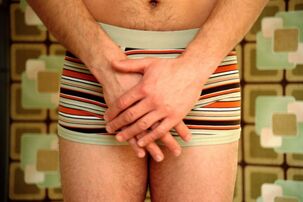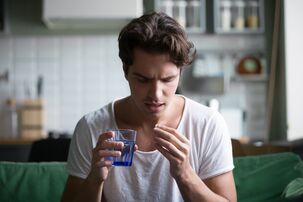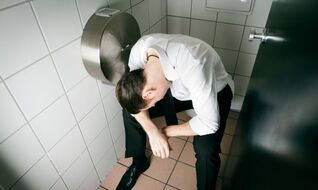Prostatitis is one of the most common urological diseases, in which it develops into an inflammatory process and covers the prostate tissue. Prostatitis can appear in men of all ages and is often accompanied by other diseases of the reproductive system. The causes of male prostatitis may be different, and in order to reduce the possibility of developing this disease, they should be considered in more detail.
Classification

Regarding the development of the pathological process, there are three main forms of prostatitis:
- Sharp.The symptoms appear suddenly and as bright as possible. Therefore, most men with a course of acute prostatitis will see a doctor on the first day of an open course. The typical symptom of the disease is severe lower back pain, which occurs because the body temperature rises to 39 degrees. In most cases, the cause of prostatitis is an infectious disease, which can develop in distant organs.
- Chronic.If acute prostatitis is not treated in time, the disease will turn into a chronic form. It is characterized by less obvious symptoms and can make the patient's overall condition satisfactory. The temperature drops to the normal limit.
- Stagnation.Non-infectious inflammatory process. It is caused by the stagnant process observed in the pelvic organs. The disease is characterized by progressive development and gradually increasing pathological symptoms. Today, this form of disease is extremely rare.
The chronic form of the disease is considered very dangerous, because most men ignore mild symptoms and therefore postpone their visit. Through this method, it is possible to develop a variety of diseases.
The disease "becomes younger" over time, so it can occur at any age.
What causes prostatitis?
This disease develops in men between 20 and 60 years of age. Therefore, unlike genitourinary system diseases, this disease cannot be called age-related. There are many causes of male prostatitis, the main reasons are discussed below.
Acute and chronic infections
Infectious lesions are the primary cause of prostatitis. When an infection enters the prostate, an inflammatory process occurs. Most often, diseases such as gonorrhea and urethritis become provocatives for these forms of prostatitis.
Pathological processes such as dental caries, tonsillitis, and tuberculosis can cause the development of infectious prostatitis.
In order to cure this disease, it is necessary to eliminate the infectious agent that is the main reason for its development. Only after the main pathogen of the infection is neutralized can prostatitis be completely cured.
Congestion

Every man should have enough sex in his life-otherwise he will not be able to get rid of prostate disease.
The consequence of a lack of regular sex life may be the development of prostate hyperemia. At the same time, the blood circulation in the organ is disturbed, causing the secret to stagnate, thereby destroying its function. All these will lead to the development of prostate deformation and inflammatory process.
Regular sexual activity can avoid stagnant prostate secretions. In addition, experts recommend that their patients avoid promiscuity by finding permanent partners.
Sedentary work
In recent decades, the trend of transition from manual labor to mental labor is very obvious. This is a sedentary lifestyle and one of the main causes of male prostatitis.
In addition, a sedentary lifestyle leads to deterioration of nerve, endocrine and cardiovascular system functions. As a result, the prostate cells absorb less oxygen, creating the best conditions for the reproduction of pathogenic microorganisms.
Although prolonged sitting is not the direct cause of prostatitis, it creates the best conditions for prostate infection. Therefore, in order to prevent prostatitis, the body should take regular physical exercises.
When living an active lifestyle, a person’s blood flow is normal and the endocrine and nervous system function better. Therefore, the prostate tissue is protected from hypoxia.
Long-term abstinence
In the absence of regular sexual activity, secretions become stagnant in the organs. In view of this, blood circulation in the prostate tissue becomes difficult. The result is the same as leading a negative lifestyle.
Hypothermia

Freezing is a definite pathological form.
Scientists believe that hypothermia is one of the main driving factors for the development of prostatitis. There are several reasons for the development of prostatitis caused by hypothermia:
- Due to hypothermia, vasoconstriction occurs, resulting in weakened tissue nutrition and deterioration of organ function.
- With the severe freezing of the human body, a person's immune system is weakened. This leads to the fact that the body is susceptible to various types of infectious injuries.
For men who have already suffered from prostatitis, hypothermia becomes particularly dangerous. Even if the disease has been cured, it can relapse.
In order to avoid the development of prostatitis, it is necessary to wear warm clothes during the cold season and avoid sitting on cold and cold surfaces. It is also forbidden to walk barefoot on a floor that is not warm enough.
Other reasons
Not only due to the above reasons, but also under the influence of the following factors, prostatitis may occur:
- Obesity;
- Poor working conditions, the perineal area bears heavy load or violent shaking;
- Hormonal imbalance;
- ARVI transferred to the leg;
- Chronic constipation.
The best prevention method is to avoid the above factors. Men who had previously suffered from prostatitis are particularly susceptible to this disease.
Who is at risk
Anyone who has had prostate problems before may face this disease again.
After considering the causes of prostatitis, it is necessary to determine the people who are susceptible to prostatitis. The following men are prone to prostatitis:

- living a sedentary lifestyle;
- Often constipation;
- Obesity;
- Engaged in sedentary work;
- Understand huge pressure and hard manual labor;
- Have irregular sexual behavior or sexual partners who change frequently;
- Previously suffering from prostatitis;
- Suffer from immune disease;
- Tobacco and alcohol abusers.
Developmental characteristics of young and old people
Prostatitis may develop into young people due to many factors. The main ones are: sedentary work, lack of mature private life, sedentary lifestyle. In order to minimize the occurrence of this disease, you must exclude these factors from your life.
In the elderly, the disease most often develops against the background of loss of sexual function. As the body ages, the reproductive system changes, and as a result, it stops functioning sooner or later. Among men aged 45 to 50, fertility is significantly reduced.
In addition, this may happen under the influence of hormonal changes in the body, which leads to a decrease in testosterone production. These changes are one of the main causes of prostatitis.
Causes of transition from the acute phase of the disease to the chronic phase
Acute prostatitis is characterized by vivid symptoms that force the patient to see a specialist, while the chronic form usually has no characteristic symptoms. In most cases, men are not in a hurry to see a doctor and notice some discomfort. As a result, the disease develops into a more serious form.
But how does this disease become a chronic disease? In most cases, the cause of the development of chronic diseases is insufficient treatment of the acute form of the disease. In this case, the transition from one form to another is under the influence of the following factors:
- Treatment started late.
- The treatment was ineffective or the wrong technique was selected.
- The patient's immune response has been greatly reduced.
- There is no cure for acute prostatitis.
It should be understood that the asymptomatic chronic disease of the inflammatory process will end in aggravation sooner or later. Then, the patient will develop all the signs of the disease, including severe pain in the perineum and lower back, difficulty urinating, and decreased sexual function.
Chronic prostatitis has an important feature: When primary inflammation of the prostate occurs, the innervation of this organ deteriorates. In turn, this has a great negative impact on his work and usually leads to autoimmune processes. In this case, the immune system begins to produce antibodies against prostate tissue. Therefore, even if the primary infection is eliminated, the development of this prostatitis cannot be avoided.
Symptoms

The main symptom of the development of prostatitis is pain. This indicates inflammation in the prostate. In this case, the unpleasant sensation may have a different nature and intensity. Urination can cause severe pain.
This disease is particularly uncomfortable and it is in the acute stage of development. In the context of severe pain, patients will experience sleep disturbances and their performance will decrease significantly, just like the overall quality of life.
Prostatitis pain has the following characteristics:
- Located at the perineum, lower abdomen, and lower back;
- Radiation to the genital area;
- When going to the toilet, the unpleasant feeling aggravates during arousal and during ejaculation;
- With sexual dysfunction.
Erectile problems are a common symptom of the chronic form of the disease. Since this dysfunction may have different degrees of performance, its treatment methods are different.
It is not uncommon for men to have slow erections and prostatitis. Most patients cannot complete sexual intercourse at all, or it is too early to ejaculate. Such diseases can negatively affect the composition of sperm.
Treatment method
The specific treatment type is determined by experts based on the characteristics of the disease process. In this case, the cause of the disease should be considered. Therefore, the main method of treating acute diseases is antibiotic therapy. Even if the disease is not bacterial, take these drugs.
Provide comprehensive treatment for chronic prostatitis. It includes the following process:
- medication;
- Physiotherapy;
- Take immunomodulators;
- Prostate massage.
If chronic prostatitis is non-bacterial, it can be treated by taking non-steroidal drugs. Sedatives are used as other treatments.
The prevention of prostatitis should be attributed to an active lifestyle, regular sexual intercourse with a regular partner, and timely treatment of infectious diseases.
























